

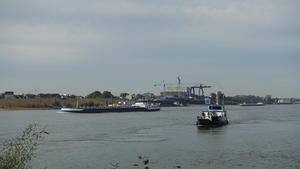
Millingen Your first experience of the Rhine is crossing it. EuroVelo 15 isn’t afraid to dart from bank to bank on the frequent ferries that connect the Netherlands’ cycle routes, and the ferry from Millingen aan de Rijn is a fine example. Restricted to bikes and pedestrians, yet nonetheless often very busy, it crosses this busy barge artery to a little cobbled promontory on the north bank. There’s frequent shipping on the river and the ferryman is adept at finding a break in the traffic to chug across.
These first 15km of the route largely cruises along the top of dykes that keep the Nederrijn in its place. Sometimes traffic-free paths, at others quiet country roads, it’s a gentle and easy introduction to cycling in the Netherlands.
After Loo, another ferry (this one accepting cars) leads to Huissen, the start of the Arnhem conurbation. You stay out of the built-up area, with the route paralleling the river until the high bridge into Arnhem.
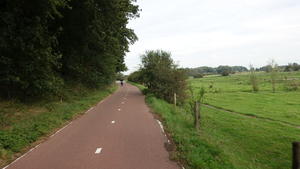
Arnhem (22km) Arnhem is a remarkable city. Substantially destroyed in the Second World War, its centre has been rebuilt with modern materials but along the original street plan. (The rest of the city changed more, and not necessarily for the better.)
Its independent cafes and restaurants, pedestrian squares and narrow streets make it a good location for an overnight stop. Walk along the riverfront then to the reconstructed church, Sint Eusebiuskerk, where you can take an escalator to the top of the tower for far-reaching views. If your hotel doesn’t have bike parking, check out the secure 2,000-space underground bike park at the railway station.
The route follows the railway closely out of Arnhem. It’s also surprisingly hilly – ok, at 50m we’re hardly talking the Alps, but nonetheless the winding route after Oosterbeek will give you a short workout. Narrow concrete paths through forestry lead to Doorwerth Castle, where the national hunting museum is an off-beat tourist attraction.
A bafflingly circuitous route around Renkum does at least pass a couple of good cafés before descending back to river level and a fabulous cycle superhighway (pictured). You don’t actually see much of the river here, save for the port on the western edge of Wageningen. This university town was where the German forces surrendered in 1945, and like Arnhem has a carefully rebuilt commercial centre.
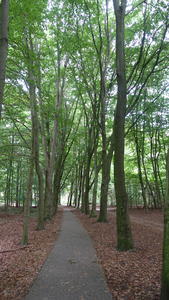
Wageningen (45km) Crossing into the province of Utrecht, the route takes on an amiable rural character. A narrow (but, as ever, immaculately smooth) path by a tree-lined canal takes you deep into cattle farming country. Dense woodland and a short sharp climb suddenly break into the town of Rhenen. The official route detours towards to the river here, but it’s just as enjoyable to cruise downhill on the main street, with cycle lanes marked out on either side.
Ready your climbing legs for the last time on this whole route. The forestry plantations between Rhenen and Amerongen are crossed by paths and tracks. Most are unpaved, but the cycle route sticks to the few paved routes, even if this does make it rather circuitous. If you’re on a traditional pedal bike, you’re sure to be overtaken by the phalanxes of locals on e-bikes as you climb towards the Sparreboomsche Berg at the dizzying summit of 55m.
(On the approach to Amerongen, note that there’s a handy bike repair station and drinking water tap at the Sportpark, on your left just before you turn towards the town.)
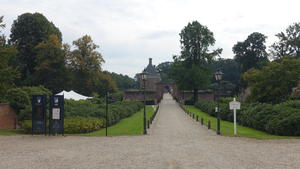
Amerongen (69km) Amerongen is a busy little tourist town, its bars and restaurants swollen by visitors to the 17th century Amerongen Castle, gardens and moat. By contrast Leersum, which follows soon after, has little to divert the cyclist.
But the meandering rural route into Wijk is a delight: tree-lined roads going nowhere fast. Keep an eye to your right near Langbroek, where you’ll see Kasteel Sandenburg, an ornate white castle which dates back to the 14th century although today’s building is mostly 19th century. It’s one of a series of castles built along the Langbroekerwetering, a medieval drainage canal, by nobles and upwardly mobile traders of the 13th and 14th centuries. Several have since been lost – for example, you’ll pass a striking bridge house across the canal which is all that remains of the historic estate of Groenestein – but you could easily piece together an itinerary exploring the survivors if you have time.
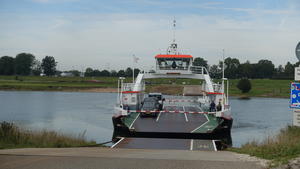
Wijk bij Duurstede (86km) There’s more to Wijk than its diminutive size might suggest, and it‘s a good choice for a lunchtime stop or even overnight. The town centre has a clutch of cafes around the Markt and the shopping street, including a vlaamse frites (Flemish fries) specialist with more types of mayonnaise than you ever thought possible.
Don’t just stick to the waymarked route, but go and explore the waterfront, particularly the drive-through windmill (Runmolenpoort) over towards the harbour. It’s an important waterway junction, the crossroads between the Nederrijn, Lek, and Amsterdam–Rhine Canal. You’ll take a ferry across the Nederrijn just north of this crossroads, then a bridge across the canal by the Prinses Marijkesluis lock. The lock is usually left open for unobstructed passage, but can be brought into use when river levels rise. This watery interlude is followed by more meanders on country lanes towards Buren, an impossibly pretty little town which fully merits the circuitous route.
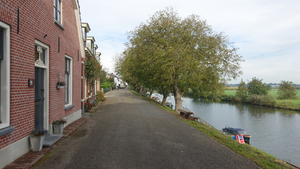
Geldermalsen (103km) EuroVelo 15 skirts the utilitarian town of Geldermalsen before embarking on one of the loveliest sections of the route. Following the River Linge on a series of quiet, winding lanes, it’s almost Loire-like in its lazy tranquility. (Fittingly, we saw half a dozen Citroen 2CVs parked in the little riverside villages.)
The Linge was once an important trading river, but its looping course has long been supplanted by the Rhine proper. Today, the only boats on the river are pleasure cruisers and day launches. Windmills and waterside cafes dot the route. It’s very different from the watery motorways at Wijk, and a beautifully unhurried experience.
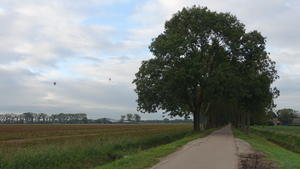
Leerdam (124km) Leerdam is on the opposite bank from the cycle route. It’s not a must-visit town but useful for shops and accommodation. The namesake Leerdammer cheese is produced a few km to the north, in Schoonrewoerd; Leerdam itself is best known for its glass industry.
Little Heukelum is a well-kept village with heraldic flags hanging from every house. As the route continues along the Linge, a rare short section of gravel surface quickly gives way to the dyke road before leaving the river and heading off cross-country. Our destination is the much wider River Waal, one of the many parts of the Rhine delta, at Gorinchem.
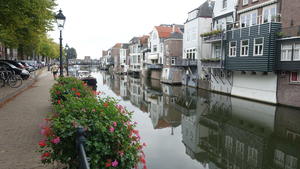
Gorinchem (139km) Gorinchem is an exceptionally fine fortified city, built to the classic plan of a near-circular city wall studded with gates enclosing a dense centre – as just one look at the map will illustrate. But Gorinchem differs in that the Linge flows right through it, while the Waal forms a southern moat. The route just follows the south-eastern quarter of the wall, but don’t skip past too quickly; take a detour to ride around the old town.
From here a ferry takes you back upstream to the lovely island town of Woudrichem, where there’s a campsite with the winning name ‘De Mosterdpot’. Tiny narrow roads through farmland trace an indirect course that seems to go out of its way to avoid any settlements, skirting Sleeuwijk and Werkendam before shaking off built-up areas for good.
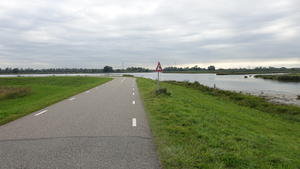
Biesbosch (165km) The Biesbosch National Park is one of the two scenic highlights of EuroVelo 15 through the Netherlands (we’ll get onto the other one later). An intricate wetland created when reclaimed polders were flooded, it was a hideout for the Resistance in the closing months of WW2. Today it’s a sanctuary for wildfowl, an oasis for birdwatchers, and a beautiful place to cycle.
The grass-roofed Biesboschmuseum at the western end will tell you more (as well as having an excellent café). Look out too for one of the drainage towers which has steps up to its roof, an excellent viewpoint.
The ferry crossing at Kop van ’t Land takes you away from the Biesbosch and over towards Dordrecht.
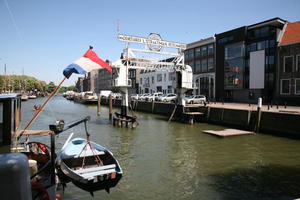
Dordrecht (188km) Disappointingly, the signposted route doesn’t go through the centre of Dordrecht. So stop following the signs (or your GPS) for a moment, and take an excursion into the historic town. “Historic” is the word: it’s one of the country’s oldest cities, rich in old buildings, home to several museums and galleries. Its many bridge crossings over the three harbour canals give it a classic Dutch atmosphere.
An express pedestrian and bike ferry takes you over the river to the tidy residential town of Papendrecht. After a largely forgettable cycleway beside main roads, a narrow lane takes you into the polderlands once again, where a network of arrow-straight drains has reclaimed the Rhine delta for farmland.
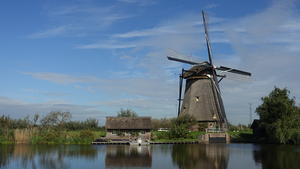
Kinderdijk (206km) We promised a second scenic highlight, and Kinderdijk is it. A long line of 18th century windmills drains the polders into the River Lek. With a watercourse either side of the narrow road, it almost feels like you’re sailing serenely along the waterway. It’s a popular tourist attraction and you’ll need to dodge the crowds as you approach the village of Kinderdijk itself, but the first stages are uncluttered and peaceful. There’s a visitor centre and cafe just before the village.
Another ferry takes you along the river to Slikkerveer, one of many settlements dominated by the marine industries. As if you needed any convincing as to the Dutch dedication to cycle infrastructure, there are two parallel routes here – a traffic-free track on the dyke and painted lanes on the minor road below. Suburban roads close to the Maas river lead to the motorway bridge where we cross onto the north bank (mercifully on the parallel cycleway); it’s quite a climb, and can be windy, too.

Rotterdam (220km) The Netherlands’ second city, Rotterdam needs little introduction. It’s a mix of historic seaport and modern commercial centre, rebuilt with startling contemporary architecture after the city was levelled in the Rotterdam Blitz of 1940. The high-rise skyline gives it the air of an American city at times, but there’s enough Continental café culture to lighten the atmosphere. (One part of the city centre is even called “Cool”…)
The cycle route clings to the riverside, so if you want to explore the city centre, look out for signs pointing you north to Centrum. The quaysides of the Maritime District are also worth exploring, and not far off the route. After the quiet of Kinderdijk, the fast-moving shoals of cyclists in Rotterdam can be quite disorientating!
From here, efficient roadside cycle paths take you out through the Rotterdam suburbs.
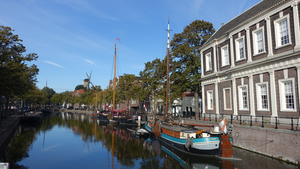
Schiedam (232km) Part of the Rotterdam conurbation, historic Schiedam deserves some time in its own right. It’s built around a network of curving canals, lined with historic mercantile buildings and crossed by elegant lifting bridges. Eight windmills stand around the city, including De Noord on Noordvest street, the tallest windmill in the world. (There were once 50 windmills in Schiedam.) A coffee beside the water in Schiedam, or perhaps a biertje later in the day, is a lovely experience.
The route returns to the banks of the Maas for a straightforward, if sometimes blustery, run to the North Sea. Modern wind turbines are the spiritual successors of Schiedam’s windmills. Vlaardingen is rather more industrial, but Maassluis has some charming streets by the town’s canals. On the opposite bank are international oil refineries and shipping terminals; the roads have an endless stream of lorries from the ferryport.
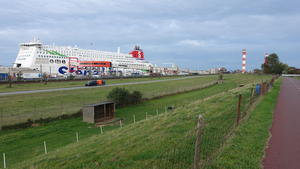
Hook of Holland (261km) At last: the end of the Rhine. Pedal up to Hook of Holland’s long sandy beach and look out to sea. Toast your achievement at one of the many cafés.
The ferry port is a short way before the coast, and has its own metro station. From here, British cyclists can take the Stena Line ferry to Harwich. Or if you’re travelling elsewhere in Europe, the metro leads back to Rotterdam for mainline connections (there or at Schiedam).
Or, of course, you could turn right and pedal up the coast – another EuroVelo route, the North Sea Cycle Route. After all, why stop now?
Log in with your cycle.travel account:
| Password |
Or simply use your account on: